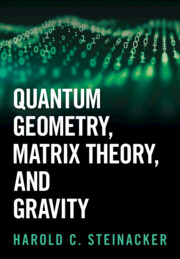‘This text provides an invaluable introduction to quantum spaces, quantum geometry and matrix models, culminating in in-depth discussions of the IKKT and BFSS matrix models, proposed non-perturbative definitions of superstring theory. I highly recommend this book to anyone seriously interested in these topics.’
Robert Brandenberger - McGill University
‘Based on the author’s renowned expertise, this insightful masterpiece delves into noncommutative geometry, matrix models, and their role in string theory and quantum gravity. The book is consistently written from a physics viewpoint with specific examples, offering fresh perspectives and suggesting fascinating possibilities for novice and seasoned researchers alike.’
Hikaru Kawai - National Taiwan University
‘The first complete book that puts together over 25 years of contemporary research connecting noncommutative field theory with gravity. Starting at a suitably pedagogical level for use as a textbook in an advanced graduate-level physics course, it elucidates state-of-the-art developments, making it an invaluable reference source for both novices and experts.’
Richard J. Szabo - Heriot-Watt University
‘Current approaches to the great puzzle of quantum gravity, with demonstrated potential for success, include string theory (or M-theory) and noncommutative geometry. This book masterfully brings together these two approaches, providing a perspective as well as background material. It will be a valuable asset to researchers in quantum gravity.’
Parameswaran Nair - The City College of New York
‘This text provides perhaps the first bridge for the uninitiated into this interesting field of research. The introductory chapters of this text are perhaps its finest, which beautifully define and explain the essential concepts needed for the proceeding discussions. Moreover, this book provides more than just a broad survey of historical results in the field, in the latter quadrants of the text, recent research is outlined in full, giving the reader a current outline of the field.’
Source: Physics Book Reviewer



